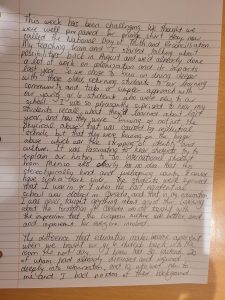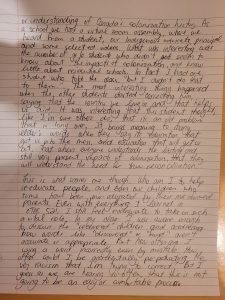

At the beginning of this task, I thought it would be significantly easier than it was. Apparently I am out of practice writing manually and tend to type when I have a large amount of text. Within the first half a page, I had to stop using my “special” pen bought for me by my late grandmother for my graduation decades ago for a wider pen with a rubber grip that didn’t hurt my hand as much. By the end of the first page, my elbow was hurting in a way that reminded me of writing exams. I found my thought process very different from when I would be typing. I would change my sentence to fit what I’d already written instead of what I was thinking because of the challenges of going back to change a word. I find I use more paragraphs and text features in my digital writing, but when hand writing I would often realize after the fact that it was a new idea that could be a new paragraph. This reminded me of the planning that went into planning of text and structure for the printing press and how they would have to completely restart if not planned well, whereas mine wasn’t planned, and I was able to let the text flow (Upside Down, Left To Right: A Letterpress Film). The flow of text can come even easier when there is no pressure around editing, adding after the fact, or deleting parts of the text when using a digital form.
There were various errors that occurred during the manual process. There was one error that I scratched out, and another where I didn’t clearly write the letters so I found I simply went over the letters in the correct form more darkly, making it bold. What was most interesting to me was that I would often change a word that I wasn’t sure how to spell to something that I was. Autocorrect is something that I have certainly gotten used to. It made me wonder how many scribes would tweak or change words for various reasons in the texts that they copied (Lamb & McCormik, 2021). Because I was using ink, a form of text technology that isn’t easily changed, I found myself self-editing and changing my writing to avoid dealing with errors in a different way. If I were using a pencil or if I was typing, I feel my text would have been different in form, text and specific wording.
Knowing how I changed my text based on what I was able to achieve with pen and paper, I feel that my thoughts are more accurately portrayed through digital means than by pen and paper. I appreciate and often write manually, but the fact that I was very easily able to change my original word choice “better” to “accurate” in the previous sentence, whereas I would shift my statement on paper to fit what I’d originally written, shows the potential shift in meaning and expression between mediums. I find myself better able to self correct, reanalyze, and edit my words as I go in a digital form which isn’t as easy in manual writing.
References:
(2021, Sept 27). Upside Down, Left To Right: A Letterpress Film [Video]. YouTube. https://youtu.be/n6RqWe1bFpM
Lamb, R., McCormik, J., (2021, May 7,). From the Vault: Invention of the Book, Part 1 [Audio podcast]. Retrieved from https://www.iheart.com/podcast/stuff-to-blow-your-mind-21123915/episode/from-the-vault-invention-of-the-82316952/
